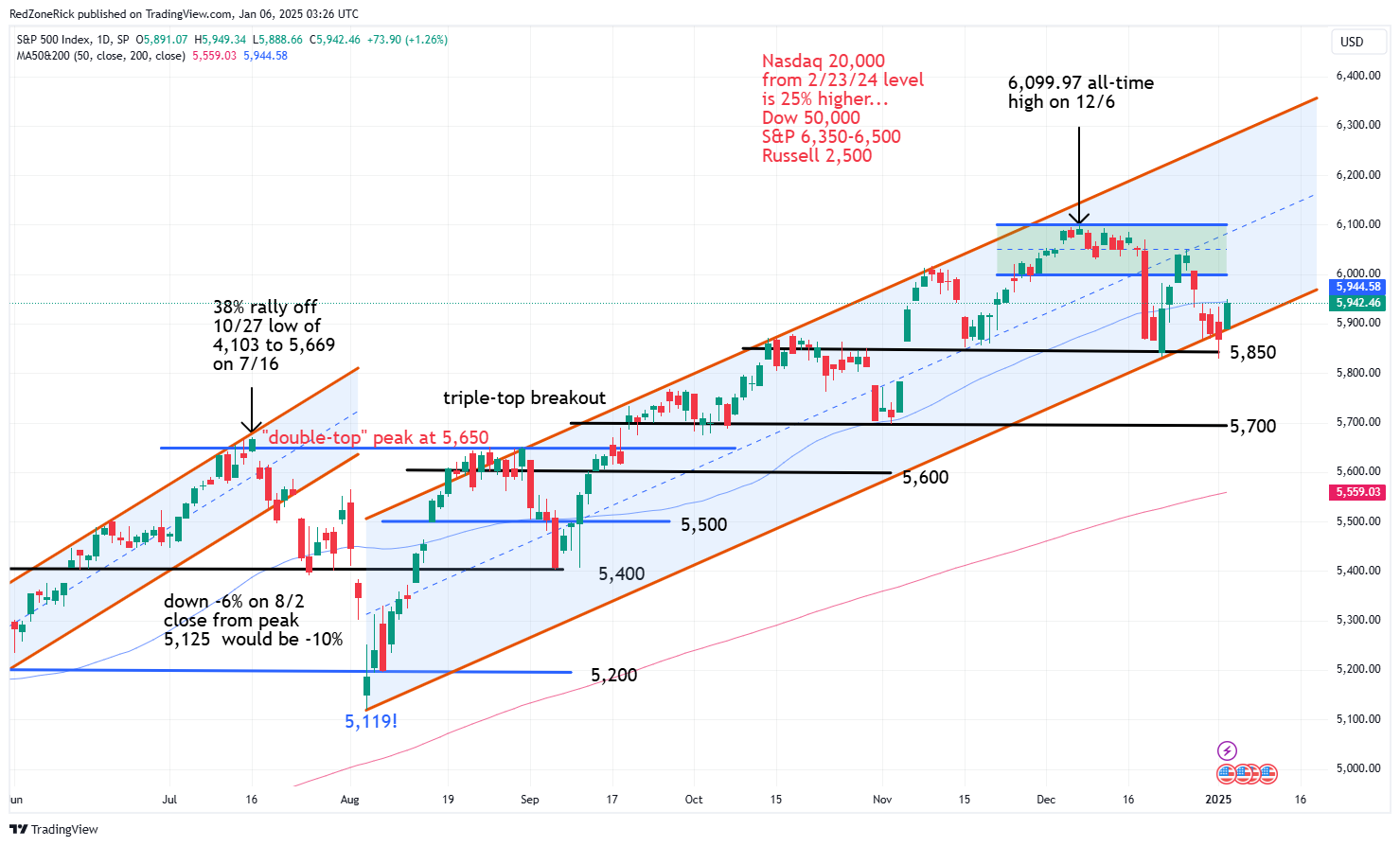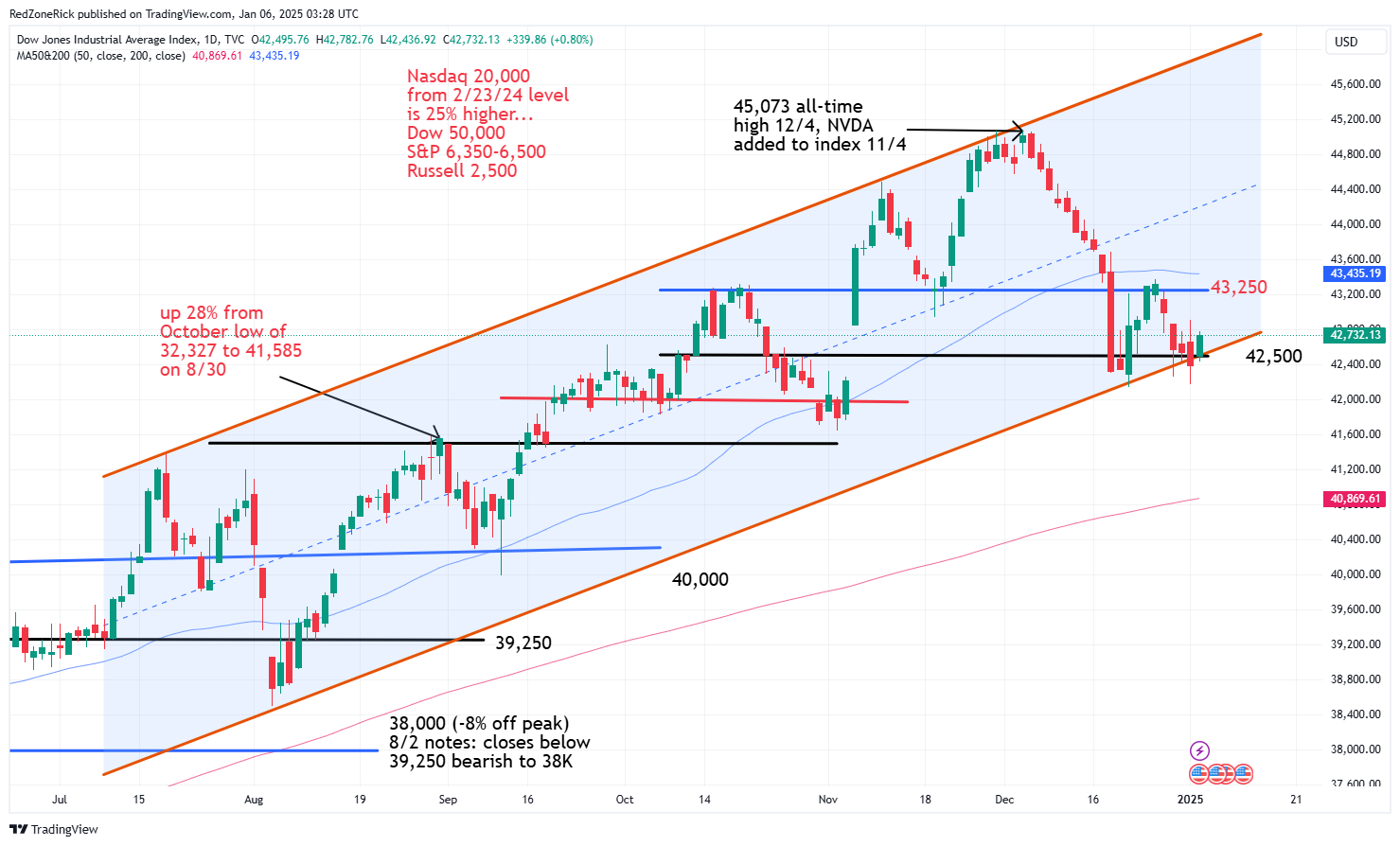No Santa “Rally” Despite Friday’s Rebound
Wall Street was higher on Friday after wrapping up a shortened week from the New Year holiday. Volatility eased after being slightly elevated over the Santa Claus rally that failed to materialize ahead of the fourth-quarter earnings season later this month.
The Nasdaq tagged a high of 19,638 before ending at 19,621 (+1.8%). Lower resistance at 19,600-19,750 was recovered. Key support is at 19,250.
The S&P 500 settled at 5,942 (+1.3%) with the high at 5,949. Lower resistance at 5,950-6,000 held. Key support is at 5,850.
The Dow topped out at 42,782 while closing at 42,732 (+0.8%). Lower resistance at 42,750-43,000 was topped but held. Key support is at 42,500.
Earnings and Economic News
Before the open: Commercial Metals Company (CMC)
After the close: None
Economic News
PMI Services Index – 9:45am
Factory Orders – 10:00am
Technical Outlook and Market Thoughts
The bulls posted another banner year as 2024 produced solid double-digit gains for the major indexes. The Nasdaq surged 29% while the S&P soared 23%. The Dow jumped over 12%.
The small-caps were up 10% in 2024 but sank 8% in December. The S&P fell 3% last month, the Nasdaq was up 0.5%, and the Dow was down 5%. The last few days of trading to close out the year were volatile as volume was light and much of Wall Street was on vacation.
The action had a big impact on any Santa Clause “rally” as it pushed all of the major indexes into the red for the last five trading days of 2024. More importantly, it pushed the Nasdaq out of its current uptrend channel and just above key support.
The aforementioned time period also included the first two trading days of the New Year but that didn’t help matters following Thursday’s pullback. The Nasdaq has fallen 143 points over the past seven sessions and the S&P has slipped 32 points. The Dow dropped 174 points, and the Russell has given back 31 points, or more than 1% to lead the losses.
The Nasdaq fell out of its current uptrend channel last Monday and briefly slipped below key support levels at 19,250 and the 50-day moving average last Thursday. Friday’s rebound reached the bottom of the channel with continued closes back above 19,750 being a renewed bullish signal for a return trip towards 20,000. The all-time high from December 16th is at 20,204.
Last Thursday’s stretch was down to 19,117 and we mentioned wiggle room down to 19,000. If breached, it would confirm a near-term top with further downside action towards 18,600.

The S&P closed below its uptrend channel last Thursday but bounced back into it on Friday. The 50-day moving average was also cleared but held by a smidge. Closes back above 6,000 and the bottom of the previous trading range would be a more bullish development.
Last Thursday’s low kissed 5,829 with multiple closes below key support at 5,850 being a bearish development. Backup support is at 5,700.

The Dow fell out of its adjusted uptrend channel last Monday and closed below key support at 42,500 on Thursday. There is additional support levels at 42,000 and 41,500.
Friday’s recovery of these levels was slightly bullish but the bigger hurdle is at 43,250 and the 50-day moving average.

The Russell dipped below crucial support at 2,225 throughout all of last week. Last Monday’s low kissed 2,202 with the next waves of support at 2,175-2,135 with the 200-day moving average at 2,163.
We continue to highlight a recovery of the 2,300 level is needed to regain a bullish thesis with a close above 2,325 and the 50-day moving average likely confirming a near-term bottom.

The Volatility Index (VIX) reached an intraday peak of 19.50 last Thursday with key resistance at 20 holding. There is risk up to 24 on a close above this level. Key support is at 15. If higher highs are to come into play for the market, the VIX will need to get closes below this level and push 13.50-12.75 during earnings season.

As a reminder, fourth-quarter and yearend earnings results will also have a major impact on market direction from mid-January and into February. The financial sector will get the action started on Thursday morning, January 16th.
When there is no Santa rally, January tends to be a bearish month for the market. If the month of January is negative, the market usually struggles to post a yearly gain. We always mention February is a tricky month to trade and why we are preparing for volatility at some point over the next few weeks and months.